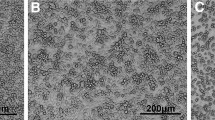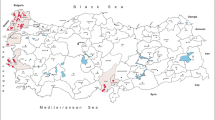Abstract
Two double-stranded RNA viruses, named Culex tritaeniorhynchus totivirus NJ2 (CTV_NJ2) and NJ3 (CTV_NJ3), were discovered from wild-captured Culex tritaeniorhynchus mosquitoes. The complete genomes (7,624 and 7,612 bp in length) were obtained using RNA sequencing. Both CTV_NJ2 and CTV_NJ3 encode a putative capsid protein and an RNA-dependent RNA polymerase. The most similar strain to CTV_NJ2/3 is Omono River virus strain AK4 (ORV-AK4). The CP and RdRp identities of AK4 are different to CTV_NJ2 (84% and 87%) and CTV_NJ3 (47% and 62%). Phylogenetic analysis showed that taxonomically speaking CTV_NJ2/3 grouped within the unclassified Totiviridae and formed a distinct clade with other arthropod-infecting viruses.
Similar content being viewed by others
Avoid common mistakes on your manuscript.
Viruses in the family Totiviridae are now been classified into five genera: Totivirus, Victorivirus, Trichomonasvirus, Giardiavirus and Leishmaniavirus [4]. However, many toti-like viruses have not yet officially been assigned to the family Totiviridae. To date, only 28 viruses have been assigned to one of the genera, according to the 10th ICTV report. Totiviruses are double-stranded RNA viruses with a genome consisting of two open reading frames (ORF) encoding a capsid protein (CP) and an RNA-dependent RNA polymerase (RdRp). The natural hosts of the classified totiviruses are protozoa and fungi. However, the unassigned toti-like viruses have a complicated and wider range of hosts including protozoa, fungi, plants, fish [2, 6, 7] and arthropods [5, 8, 10, 12]. To date, three reported toti-like viruses have been isolated from mosquitoes: Armigeres subalbatus virus SaX06-AK20 (AsTV) isolated from Armigeres subalbatus [12] and Omono River viruses ORV-AK4 and ORV-Y61 isolated from Culex inatomii [3]. In this paper, we report another two toti-like viruses isolated from Culex tritaeniorhynchus, whose genomes and coding proteins are distinct from previously reported toti-like viruses.
Mosquitoes were sampled during the active mosquito season (from June to September) in Yunnan Province, southwest China, from 2007 to 2010 using light traps baited with CO2. Collected mosquitoes were grouped into separate pools based on collection site and mosquito classification. Each mosquito pool included approximately 50–100 mosquitoes. Each pool of samples were milled and cultured with Aedes albopictus C6/36 cells. The pools that caused cytopathic effect (CPE) were selected to extract virus particles and inoculate new cell lines. C6/36 cell culture supernatants inoculated with virus for 3d were used for virus purification. Viruses from other virus families were found in some of the pools, published previously [9, 13]. Two novel viruses were obtained from another two collection pools of Culex tritaeniorhynchus.
Viral RNA was extracted using the QiagenViral RNA Mini Kit (Qiagen, Valencia, CA, USA) and used to construct a cDNA library according to the manufacturers’ protocols using the Ion Total RNA-Seq Kit V2 (Life Technologies). The library was subsequently sequenced with the Ion Torrent™ sequencing platform. A total of 567,338 and 372,958 raw reads were generated and assembled into CTV_NJ2 and CTV_NJ3 using Newbler (version 2.8). The average reads length of CTV_NJ2 and CTV_NJ3 were 154 bp and 163 bp, respectively. The ORFs were detected using Glimmer [1]. CTV_NJ2 is 7,624 nucleotides in length and encodes two ORFs, a 1689 aa putative CP and a 876 aa RdRp. CTV_NJ3 is 7,612 nucleotides in length and encodes a 1686 aa CP and 842 aa RdRp protein. Both of them have a putative RdRp motif (RDRP-4). The blastp analysis of the amino acid sequences revealed that the CP of CTV_NJ2 and CTV_NJ3 shared the highest identities to that of strain ORV-AK4 (84% and 47%, respectively) and 46% between themselves. The blastp results for the RdRp were similar (CTV_NJ2, 87% to ORV-AK4; CTV_NJ3, 62% to ORV-AK4; and 60% between themselves). The complete genomes were deposited in GenBank with the accession numbers KX456218 (CTV_NJ2) and KX456219 (CTV_NJ3).
To explore the relationships of CTV_NJ2/3 with other classifiable members of the family Totiviridae, all 28 assigned viruses and 23 toti-like unclassified viruses (supplemental table) were selected to generate a tree based on the RdRp gene (Figure 1). The natural hosts of the 51 viruses are indicated with colored triangles. The 28 assigned strains grouped into five main clades, which were consistent with the current classification (grey area). However, viruses that infect arthropods were grouped into a large clade. The strains isolated from mosquitoes (AsTV, ORV-AK4, ORV-Y61, CTV_NJ2, CTV_NJ3) were closest in terms of their phylogenetic placement. Interestingly, TJV was isolated from bat feces [11], and GSTV was isolated from golden shiner [6], which are both insectivorous animals feeding on insects, especially mosquitoes. The phylogenetic analysis showed a distinctive feature: all the arthropod-infecting toti-like viruses grouped in a clade. This may indicate a novel genus should be assigned to family Totiviridae, as proposed by Yougang Zhai et al[12].
A phylogenetic tree comparing 50 viruses classifiable within the family Totiviridae (based on the RdRp protein). The 28 officially assigned viruses are in black font while the 23 unassigned toti-like viruses are in red. The grey area represents the current classification of the five genera, while the black circles indicate the representative strains. CTV_NJ2/3 are marked with hollow red rings. Viral hosts are distinguished using different colored triangles near the strain name: black for protozoa, green for fungi, blue for plants, light blue for fish and red for arthropods. The white triangle represent other hosts, such as bat feces. The phylogenetic tree was constructed with the maximum likelihood method, with a 1000-replicate bootstrap test
With the increasing number of toti-like viruses being identified, the current classification is no longer sufficient to represent all the viruses classifiable within family Totiviridae. CTV_NJ2 and CTV_NJ3 formed a distinct clade with other arthropod-infecting toti-like viruses. CTV_NJ2/3 were isolated from asymptomatic adult mosquitoes and are genetically distinct from any previously reported totiviruses. Characterization of their virulence and their host range warrants further investigation.
References
Delcher AL, Harmon D, Kasif S, White O, Salzberg SL (1999) Improved microbial gene identification with GLIMMER. Nucleic Acids Res 27:4636–4641
Haugland O, Mikalsen AB, Nilsen P, Lindmo K, Thu BJ, Eliassen TM, Roos N, Rode M, Evensen O (2011) Cardiomyopathy syndrome of atlantic salmon (Salmo salar L.) is caused by a double-stranded RNA virus of the Totiviridae family. J Virol 85:5275–5286
Isawa H, Kuwata R, Hoshino K, Tsuda Y, Sakai K, Watanabe S, Nishimura M, Satho T, Kataoka M, Nagata N, Hasegawa H, Bando H, Yano K, Sasaki T, Kobayashi M, Mizutani T, Sawabe K (2011) Identification and molecular characterization of a new nonsegmented double-stranded RNA virus isolated from Culex mosquitoes in Japan. Virus Res 155:147–155
Matthews REF (2012) Virus taxonomy: classification and nomenclature of viruses: ninth report of the international committee on taxonomy of viruses. Encyclopedia Virol 140:9–23
Koyama S, Urayama S, Ohmatsu T, Sassa Y, Sakai C, Takata M, Hayashi S, Nagai M, Furuya T, Moriyama H, Satoh T, Ono S, Mizutani T (2015) Identification, characterization and full-length sequence analysis of a novel dsRNA virus isolated from the arboreal ant Camponotus yamaokai. J Gen Virol 96:1930–1937
Mor SK, Phelps NB (2016) Molecular detection of a novel totivirus from golden shiner (Notemigonus crysoleucas) baitfish in the USA. Arch Virol 161:2227–2234
Mor SK, Phelps NB (2016) Detection and molecular characterization of a novel piscine-myocarditis-like virus from baitfish in the USA. Arch Virol 161:1925–1931
Poulos BT, Tang KF, Pantoja CR, Bonami JR, Lightner DV (2006) Purification and characterization of infectious myonecrosis virus of penaeid shrimp. J Gen Virol 87:987–996
Sun Q, Zhao Q, An X, Guo X, Zuo S, Zhang X, Pei G, Liu W, Cheng S, Wang Y, Shu P, Mi Z, Huang Y, Zhang Z, Tong Y, Zhou H, Zhang J (2017) Complete genome sequence of Menghai rhabdovirus, a novel mosquito-borne rhabdovirus from China. Arch Virol 162:1103–1106
Wu Q, Luo Y, Lu R, Lau N, Lai EC, Li WX, Ding SW (2010) Virus discovery by deep sequencing and assembly of virus-derived small silencing RNAs. Proc Natl Acad Sci USA 107:1606–1611
Yang X, Zhang Y, Ge X, Yuan J, Shi Z (2012) A novel totivirus-like virus isolated from bat guano. Arch Virol 157:1093–1099
Zhai Y, Attoui H, Mohd Jaafar F, Wang HQ, Cao YX, Fan SP, Sun YX, Liu LD, Mertens PP, Meng WS, Wang D, Liang G (2010) Isolation and full-length sequence analysis of Armigeres subalbatus totivirus, the first totivirus isolate from mosquitoes representing a proposed novel genus (Artivirus) of the family Totiviridae. J Gen Virol 91:2836–2845
Zhang X, Guo X, Fan H, Zhao Q, Zuo S, Sun Q, Pei G, Cheng S, An X, Wang Y (2017) Complete genome sequence of Menghai flavivirus, a novel insect-specific flavivirus from China. Arch Virol 162:1435–1439
Acknowledgements
This research was supported by a grant from The National Key Research and Development Program of China (2016YFC1202705,SKLPBS1518,AWS16J020 and AWS15J006), the National Natural Science Foundation of China (81572045, 81672001, and 81621005).
Funding
This study was funded by 2016YFC1202705 (The National Key Research and Development Program of China).
Author information
Authors and Affiliations
Corresponding authors
Ethics declarations
Conflict of interest
There is no conflict of interest for all the authors.
Ethical approval
This article does not contain any studies with human participants or animals performed by any of the authors.
Additional information
Handling Editor: Ayato Takada.
Electronic supplementary material
Below is the link to the electronic supplementary material.
Rights and permissions
About this article
Cite this article
Huang, Y., Guo, X., Zhang, S. et al. Discovery of two novel totiviruses from Culex tritaeniorhynchus classifiable in a distinct clade with arthropod-infecting viruses within the family Totiviridae. Arch Virol 163, 2899–2902 (2018). https://doi.org/10.1007/s00705-018-3871-1
Received:
Accepted:
Published:
Issue Date:
DOI: https://doi.org/10.1007/s00705-018-3871-1





